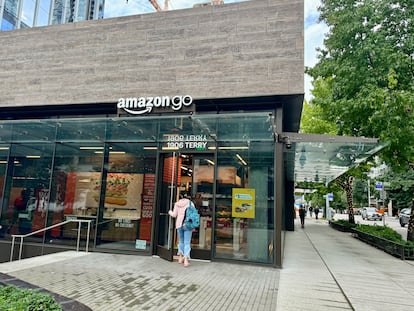This is what Amazon Go’s self-service supermarkets with no cashiers are like
EL PAÍS visits a Seattle store where multiple cameras detect what products customers are taking with them

In just 34 seconds, customers can enter an Amazon Go supermarket, grab a product and exit with their purchase, says an employee of the store in Seattle. How? No cashiers. At the entrance, a bright yellow sign cheerfully advertises “Breakfast sandwiches for $3.” It’s only half past seven in the morning, but customers steadily stream in and out with no waiting at the checkout counter.
We were invited by the ecommerce giant to visit an Amazon Go store located in downtown Seattle, on the corner of Terry Avenue and Stewart Street. The supermarket is only open on weekdays, from 7 a.m. to 8 p.m. With only three aisles, it feels small compared to other American supermarkets. The ceiling is covered with cameras that “identify individual customers and record the items they select,” said a store employee. Amazon doesn’t provide much information about the system, but says it uses computer vision, sensors and deep learning techniques. “When you grab something off the shelf, it gets added to your virtual cart automatically. And if you decide to put it back, it gets removed from the virtual cart too.”
Most of the customers today are in a rush and don’t stop to talk to anyone. Anna says she typically visits this store once or twice a month. “Usually, I shop at other supermarkets, but this one is super convenient if you’re looking for something specific that you can’t find in the vending machines at work. Like this Olipop Vintage Cola,” she said, showing us the retro soda pop she just bought. Nathan, who works in another Amazon business, tells us he comes to this store because “it has a pretty good selection of products, and you can get in and out quickly.”
The customers we talked to all mention the quick buying experience. One shopper says many are coworkers at the nearby Seattle Children’s Research Institute. Chun-Yu Chen says speed and the occasional discounts as an Amazon Prime member are what brings him here twice a week. Most of the shoppers say the main disadvantage is that the store is small and doesn’t have the broad product selection of a traditional supermarket. Chen tells us, “the food is always the same.” Near the door is an assortment of salads, sandwiches and prepared food — pasta, meatballs, sushi and poke — ranging in price from $8 to $13. There are all sorts of snacks available like energy bars, chocolate bars, and a variety of chips in jalapeño and other flavors. You can also find gourmet venison and wagyu beef jerky, as well as healthier items like fresh fruit cups.
The overall feel of the store is that everything is meant for immediate consumption. There is very little uncooked food — no raw vegetables, legumes or pasta — and the beverages are often supersized. The energy drinks and milk — cow, soy and almond — are only available in hefty half-gallon sizes. Coffee-to-go is available from the store’s two Starbucks vending machines.
The supermarket has a shelf for Amazon Basics products, like phone charging cables and batteries. Just below are over-the-counter medications — ibuprofen, paracetamol, antihistamine — and dietary supplements for stress to help you “stay calm and alert.” This section also offers toothpaste, mouthwash, garbage bags, condoms and even pregnancy tests.
The Amazon Go markets have detractors, of course. Jordan, a young woman who oversees volunteer services at a small, local nonprofit, said, “There are so many reasons why I try not to order things on Amazon or shop at Amazon Go.” While she worries about Amazon collecting data on her spending habits, it’s not the main reason she avoids shopping there. “It’s kinda tough to buy something online without your data being collected, right? Unfortunately, that’s the world we live in.”

Jordan then tells us the real reason she avoids Amazon. “This company has been violating workers’ rights for years, selling its services to fossil fuel companies, and hurting small, independent businesses. On top of that, there are even accusations of systemic racism in its offices. It’s also aggressively anti-union, which is totally against workers’ rights.”
An Amazon spokesperson says employees have “competitive salaries and benefits that include private health insurance, a retirement savings plan and education funds.” Its relationship with small and medium-sized businesses (SMEs) is collaborative: “Our success depends on your success,” he said. Regarding the sale of services to fossil fuel companies, the company believes that the energy sector needs access to innovative technologies, particularly during this significant energy transition. The company also denies allegations of anti-unionism and emphasizes its commitment to respect and value individuals regardless of their background, gender, race, ethnicity, religion, sexual orientation and abilities.
Pay with the mobile app or your palm
There are currently two types of Amazon Go stores. At most of them, you can open the doors using the Amazon app, a credit card or your palm. When you leave, the app automatically charges your account for the items you purchased. Some stores like the one we visited allow customers to enter freely, but you have to stop at the self-service checkout counter before leaving. That’s where you can pay by scanning the app, using your credit card or placing your palm on a reader. Known as Amazon One, the palm option is only available to users who have previously recorded palm scans on the premises. As a last resort, you can try and find a store employee and pay with cash.
Some argue that this kind of supermarket could impact job availability. Amazon, however, says that even though there are no cashiers, it still relies on workers in the stores. In fact, Amazon stresses that its in-store team plays a crucial role in the Amazon Go experience. “You’ll see employees greeting shoppers at the door, restocking shelves, answering questions, helping with Amazon online returns, and making product recommendations.”
When we visited the Amazon Go in Seattle, there was only one worker in the store whose main job seemed to be troubleshooting problems. One man came back in the store because he thought he left without paying. “I think I did something wrong,” he said worriedly. Holding a bag of groceries, he pointed to his phone and said he hadn’t been charged. The employee reassured him and said the receipt usually takes at least an hour. Laughing, the customer left.
Sign up for our weekly newsletter to get more English-language news coverage from EL PAÍS USA Edition
Tu suscripción se está usando en otro dispositivo
¿Quieres añadir otro usuario a tu suscripción?
Si continúas leyendo en este dispositivo, no se podrá leer en el otro.
FlechaTu suscripción se está usando en otro dispositivo y solo puedes acceder a EL PAÍS desde un dispositivo a la vez.
Si quieres compartir tu cuenta, cambia tu suscripción a la modalidad Premium, así podrás añadir otro usuario. Cada uno accederá con su propia cuenta de email, lo que os permitirá personalizar vuestra experiencia en EL PAÍS.
¿Tienes una suscripción de empresa? Accede aquí para contratar más cuentas.
En el caso de no saber quién está usando tu cuenta, te recomendamos cambiar tu contraseña aquí.
Si decides continuar compartiendo tu cuenta, este mensaje se mostrará en tu dispositivo y en el de la otra persona que está usando tu cuenta de forma indefinida, afectando a tu experiencia de lectura. Puedes consultar aquí los términos y condiciones de la suscripción digital.
More information
Archived In
Últimas noticias
Welcome to the post-religion era: The idea of Christianity as the absolute truth has become obsolete
‘I thought you would like it’: The risky sexual practice popularized by TV shows and TikTok
The digitalization of tourism: ‘They promise experiences and gave us the worst possible one’
Mexican peso defies uncertainty with forecasts of a new period of stability in 2026
Most viewed
- Sinaloa Cartel war is taking its toll on Los Chapitos
- Reinhard Genzel, Nobel laureate in physics: ‘One-minute videos will never give you the truth’
- Oona Chaplin: ‘I told James Cameron that I was living in a treehouse and starting a permaculture project with a friend’
- Why the price of coffee has skyrocketed: from Brazilian plantations to specialty coffee houses
- Silver prices are going crazy: This is what’s fueling the rally











































